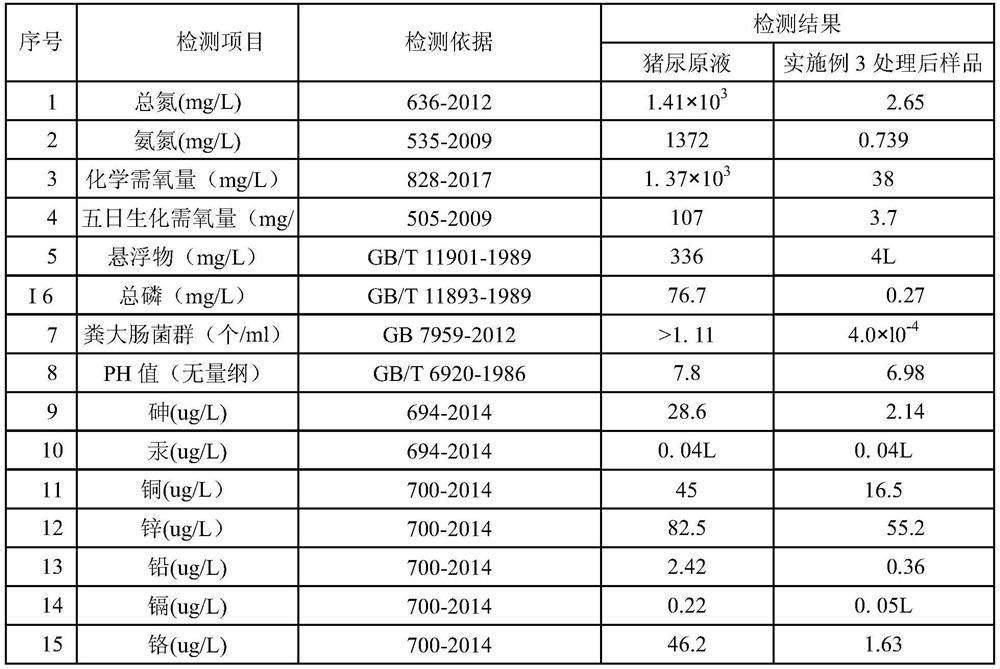Method for treating livestock and poultry sewage by using hydroponic protein grass
A technology for livestock and poultry and sewage, applied in the field of hydroponic protein grass treatment of livestock and poultry sewage, can solve the problems of high sewage treatment operation cost and less design, and achieve the effects of increasing farmers' income, preventing seedling burning, and reducing environmental protection pressure.
- Summary
- Abstract
- Description
- Claims
- Application Information
AI Technical Summary
Problems solved by technology
Method used
Image
Examples
Embodiment 1
[0033] A method for treating livestock and poultry sewage with hydroponic protein grass, comprising the following steps:
[0034] S1. Dilute the livestock and poultry sewage with water, and adjust the pH and conductivity.
[0035] S2. Adding sterilizers and insecticides to the diluted livestock and poultry sewage.
[0036] S3. Adding 1% by volume formulation solution to the livestock and poultry sewage treated in step S2.
[0037] According to mass ratio, the preparation solution includes: 10% biological enzyme, 1% urease, 15% mineral and 1% peroxide, and the rest is water.
[0038] S4. Transplant the protein grass seedlings into the livestock and poultry sewage treated in step S3, and carry out hydroponics.
[0039] S5. Harvest once every 20-30 days of hydroponics.
Embodiment 2
[0041] A method for treating livestock and poultry sewage with hydroponic protein grass, comprising the following steps:
[0042] S1. Dilute the livestock and poultry sewage with water, and adjust the pH and conductivity.
[0043] S2. Adding sterilizers and insecticides to the diluted livestock and poultry sewage.
[0044] S3. Adding 5% of the prepared solution by volume to the livestock and poultry sewage treated in step S2.
[0045] According to the mass ratio, the preparation solution includes: 5% biological enzyme, 3% urease, 5% mineral and 5% peroxide, and the rest is water.
[0046] The biological enzymes include cellulase, pectinase, amylase and catalase.
[0047] The minerals include 0.01 part of silicon, 500 parts of calcium, 100 parts of magnesium, 1000 parts of potassium, 0.8 part of iodine, 0.05 part of selenium, 0.01 part of iron and 0.05 part of molybdenum in parts by weight.
[0048] S4. Transplant the protein grass seedlings into the livestock and poultry se...
Embodiment 3
[0051] A method for treating livestock and poultry sewage with hydroponic protein grass, comprising the following steps:
[0052] S1. Dilute the livestock and poultry sewage with water, and adjust the pH and conductivity.
[0053] Control the conductivity of the diluted livestock and poultry sewage to 1.0-3.0mS / cm, and control the pH to about 6.5. After the protein grass seedlings are transplanted, the conductivity is controlled to 1.5mS / cm in the first 3 to 7 days; after that, the conductivity is controlled to 2.5mS / cm. Use a water quality detection pen to monitor the conductivity in real time.
[0054] S2. Adding sterilizers and insecticides to the diluted livestock and poultry sewage.
[0055]The sterilant is the German imported Octex plant disinfectant.
[0056] The insecticide is a plant insecticide. The plant insecticide is a plant insecticide produced by Shenzhen Lvsen Biotechnology Co., Ltd.
[0057] S3. Adding a 3% preparation solution by volume to the livestock ...
PUM
| Property | Measurement | Unit |
|---|---|---|
| distance | aaaaa | aaaaa |
Abstract
Description
Claims
Application Information
 Login to View More
Login to View More - R&D
- Intellectual Property
- Life Sciences
- Materials
- Tech Scout
- Unparalleled Data Quality
- Higher Quality Content
- 60% Fewer Hallucinations
Browse by: Latest US Patents, China's latest patents, Technical Efficacy Thesaurus, Application Domain, Technology Topic, Popular Technical Reports.
© 2025 PatSnap. All rights reserved.Legal|Privacy policy|Modern Slavery Act Transparency Statement|Sitemap|About US| Contact US: help@patsnap.com

